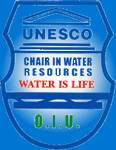As recognized experts in the application of hydrologic and hydraulic computer models, UNESCO-CHAIR in Water Resources, will routinely offers the following training courses to governmental agencies, educational institutions and private companies to enhance their capacity in the area of hydrologic & hydraulic modeling. The courses attempt to fill in the gap between theory and practice in the field of water resources engineering. These services will include training course on the use of the U.S. Army Corp of Engineers Hydrologic Engineering Center’s (HEC) Hydrologic Modeling System (HEC-HMS) and Hydraulic River System Analysis (HEC-RAS).
This is 7 days short training course aimed to equip civil engineers in the field of hydrology, hydraulic, irrigation engineers, land development consultants and municipal drainage engineers with the latest technology of modeling and hydraulic analysis. Each course is designed to provide an overview on model, its use, basic principles together with illustration example and a workshop session to teach the practical use of the software. The series of training courses is tailored more to the practical implementation of the software in the field of design and real world analysis rather than providing theoretical background on Civil Engineering and hydraulic analysis.
HEC-HMS is the latest rainfall-runoff simulation model that widely and commonly used in the design and planning of water resources and urban drainage system. The HEC-HMS training course teaches the participant how to construct watershed models in HMS and calibrate the model parameters through optimization methods. Student gain valuable hands-on experience in applying the model through numerous computer workshops. Hydrologic principals and their application to modeling in HMS are discussed throughout the course. Basin rainfall, precipitation loss rate, unit hydrograph transformation, and channel routing model components are explained. In addition GIS processing capabilities and applications are also presented.
The HEC-RAS modeling system was developed as part of the Hydrologic Centers Next Generation Models and incorporates various aspects of hydraulic modeling, including water surface profile computations and bridge hydraulics. HEC-RAS advances in open channel hydraulics include
-
Availability of widely used methods for bridge and culvert hydraulic analysis.
-
Ability to perform bridge scour analysis including pier contraction and abutment scour
-
Automated analysis of sub critical and supercritical flow regime in a single analysis.
HEC-RAS and HEC-HMS are user friendly packages with Graphical User Interface (GUI) technology for data entry, graphics and display of the program results.
- Learn how to use the HEC-HMS and HEC-RAS computer programs.
- Gain hands on HEC-HMS and HEC-RAS experience by practipating in the practical computer workshop.
- Get an overview of hydrology and hydraulics principles for design and modeling of river system, waterways, bridges and culverts.
- Optimize the effectiveness of your next drainage system project or flood control projects.
- Obtain valuable insights in model development and urban drainage system design.
Workshop and training course participant will receive the following publications and software:
- HEC-HMS & HEC-RAS software (latest Version)
- HEC-HMS & HEC-RAS User Manuals
- HEC-HMS and HEC-RAS Example problems
- Consulting Civil Engineers
- Water Resources Planners
- Municipal and Irrigation Engineers
- Educational institutions
- Highway consultants and urban system design engineers.
- Overview of rainfall-runoff processes
- Introduction to HMS capabilities and features
- Basin Rainfall Distribution Estimation
- Rainfall loss rate computations
- Transform concepts
- Channel Routing
- Computer workshop on rainfall-runoff modeling
- Reservoir routing
- Computer workshop on reservoir routing and pond design
- How to configure a system or network of sub basin
And reservoir element selecting the appropriate routine technique
- Optimization in HMS
- Parameter Calibration
- Computer workshop on parameter optimization
- Multiple sub basin and river reach modeling
- Computer workshop on multiple basin modeling and water resources allocation
- Overview of GIS applications.
- Computer workshop on GIS Application
- Overview of HEC-RAS capabilities
- Basic hydraulic modeling development
- Computer workshop on basic model development
- Modeling tributary junctions
- Computer workshop on modeling tributary junctions
- Modeling ineffective flow areas and levees
- Basic Hydraulic theory
- Modeling bridges
- Computer workshop on modeling bridges
- Modeling culverts
- Modeling multiple openings
- Computer workshop on modeling openings
- Computer workshop on floodway determinations
- Computer workshop on output analysis.
Another prime objective of the UNESCO-CWR is to facilitate and coordinate research collaboration between Universities and research institutions nationally and regionally.
UNESCO-CWR, in meeting its goals, created four working themes that address the above objectives. These themes are: Research studies, Capacity Building, Collaboration & Networking, Consultancy and Documentation & Dissemination of findings.
